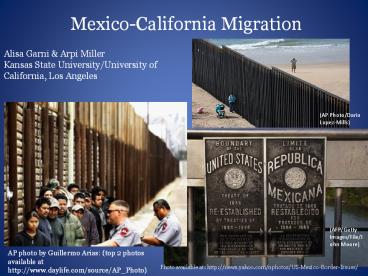Mexico-California Migration PowerPoint PPT Presentation
Title: Mexico-California Migration
1
Mexico-California Migration
Alisa Garni Arpi Miller Kansas State
University/University of California, Los Angeles
(AP Photo/Dario Lopez-Mills)
(AFP/Getty Images/File/John Moore)
AP photo by Guillermo Arias (top 2 photos
available at http//www.daylife.com/source/AP_Phot
o)
Photo available at http//news.yahoo.com/nphotos/
US-Mexico-Border-Issues/
2
Relevant Nodal Points/Policy and Plans
- Variable nexus between different policy spheres
and aspects of migration project - Policies Federal, state, local
- Questions of implementation
- Anticipation and enforcement!
- Migration project (actual anticipated)
- Initial trip
- Circular migration
- Settlement
3
Relevant nodal points/Migrant response
- Response to different policies varied
- personal circumstances
- migration goals
- stage within the migration project
- social context
- Local social, economic, political environment and
urban infrastructure affects actual nodal points
4
Actual nodal points?
- Three kinds of response to policy
- Ignoring policy ? no change in behavior but
exposure to risk - Initial migration, driving and working without
permission - Slight modification in behavior
- Driving new routes (police harassment)
- Significant modification in behavior
- Life changing decisions to move, delay migration
(or return), change jobs, etc.
5
Types of Policies
- Overall Federal policy significant however, in
absence of favorable federal reform, state and
local policies become more salient
6
State-level enforcement of federal policy
From left to right California Govenor Arnold
Schwarzenegger with Cabinet Secretary Dan
Dunmoyer and U.S. Department of Homeland Security
Secretary Michael Chertoff at the 26th Border
Governors Conference (August 2008) Gov.
Schwarzenegger delivers a presentation at same
conference. Photos and news story from REUTERS.
Available at http//www.daylife.com/search/photos
/all/3?qU.S.Mexicoborder
7
- Local level policies
- State level denial of access to identity
documents - State/municipal level crack downs on landlords,
employers - Police harassment
8
Policy Characteristics Restrictive vs.
Expansionary
- Restrictive policies ? greatest impact
- Prompted both moderate and significant
modifications in behavior - Expansionary policy?
- Hiring practices
- News about local rights in other statesdraw
- Anticipation of federal reform
9
Information?
- Sources
- Family, social networks
- Spanish language media broadcasts/news
- Churches and other social services
- Content
- Federal policy/questions of reform
- Bad neighborhoods
- Police checkpoints
- Employment information
- Goods and services (e.g., housing,
transportation) - Obtaining identification documents
10
Networks
- Social networks (broader than kinship) were most
significant - Professional networks significant in initial
trip, also assisted migrants in overcoming
obstacles to living and working in U.S. - Exposure to risk, exploitation
11
Typology of the Mexico-California Case
- Unauthorized migrants embedded in a historically
well-developed migratory pattern
12
Migrant Typologies
- High-skilled
- Family reunification
- Asylum/refugee (gender cases)
- Temporary visa carriers
- Unauthorized
13
Typology of Unauthorized Migrant
- Leaders/followers
- Pioneers in family later migrants reuniting
- Lone/Accompanied
- Qualitative differences for lone vs. family based
- Gender
- Differences in networks, access to jobs,
transport - More/less entrenched in U.S. society
- Deeply invested, newly arrived
14
Conclusions
- After arrival, state/local level policies and
practices increasingly affect migrant routines,
options, decisions, and quality of life. - Mediating factors between policy and behavior
- Local context (including infrastructure)
- Degree of investment
- Personal characteristics
15
Conclusions (cont.)
- Restrictive policies frequently fail to dissuade
migrants in pursuing projects ? forced to adapt,
potentially suffer physical and mental strain,
economic hardship and social isolation. - Need to better understand the geographical and
political realities of a migrant destination, as
well as the diverse and particular situations of
the migrants within it
16
Emergent research questions
- What is the relationship between the local
context in which a policy is encountered and the
efficacy of that policy (manifest vs. latent
function)? - What is the relationship between unauthorized
migrants degree of investment in host context
and the way in which a policy is experienced?
17
Tentative Hypotheses
- Inverse relationship between extensiveness of
local infrastructure (formal and informal) and
the degree to which migrants are affected by
restrictive policies (though risk remains) - The more invested unauthorized migrants are in
the host context, the more deeply they will be
affected by restrictive policies, but the less
likely they will be to modify their behavior

